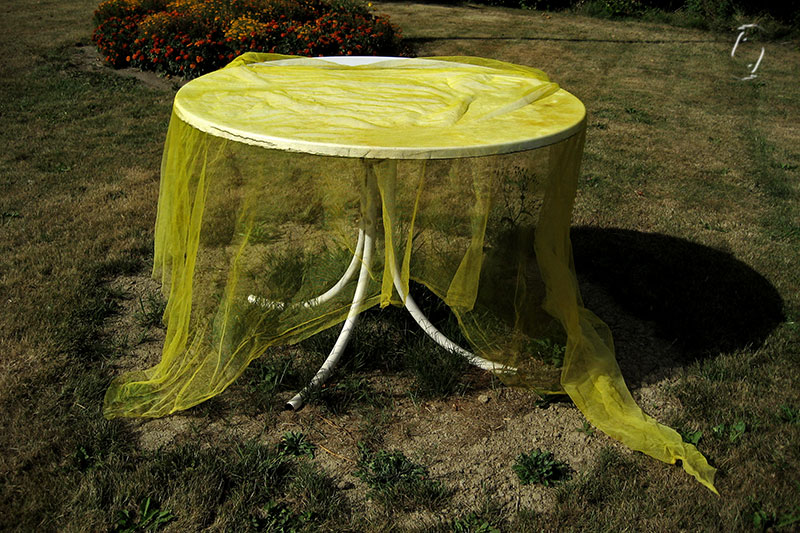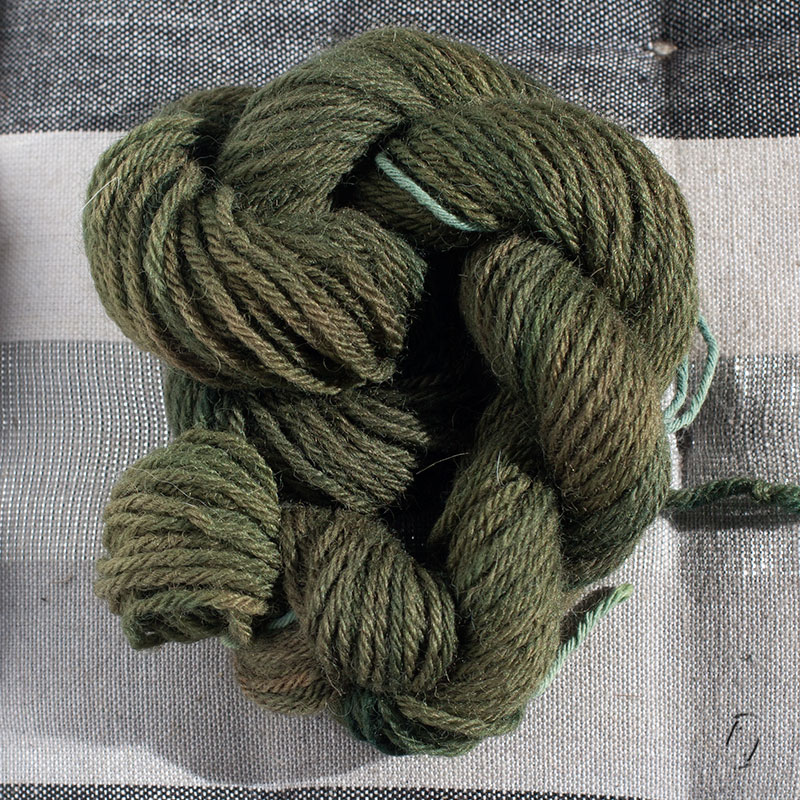You don’t have to believe your judgments, they’re simply an old habit.
Tag: yellow
Weld – reseda luteola – farvevau
 I wasn’t actually sure if my weld plants would grow big enough the first year (my previous batch didn’t), nor whether I could use the leaves from the rosettes, or have to wait for stalks.
I wasn’t actually sure if my weld plants would grow big enough the first year (my previous batch didn’t), nor whether I could use the leaves from the rosettes, or have to wait for stalks.
Turns out the first year leaves dye just fine. In fact, so well that most of the dyestuff from the first pot ended up on the synthetic tulle that I used to submerge the plant matter! I use a large canner for plants that need a controlled temperature, and it has a hotplate IN the water, so I figured I need to keep the plants away from it.
As you can see in the top and bottom photos, the plants thrive much better in my prepared, watered and weeded patch in the garden than the rough living in my overgrown abandoned veggie garden.
So anyway, the yarn afterwards looked really bleak compared to the tulle, so I ended up picking more leaves and just tossing them in on top. I just did 2 wool skeins with some cotton tests, then did another batch with a strainer over the hot plate instead for the rest of the wool. Much better.
Also a single copper skein, rhubarb, and some in blue pots, one of each type.
 Weld likes chalky water and temps below 70 C. Solar dyeing on silk wasn’t that great a succes though, at least not with just the leaves in the jar and no artificial heating.
Weld likes chalky water and temps below 70 C. Solar dyeing on silk wasn’t that great a succes though, at least not with just the leaves in the jar and no artificial heating.
Big bag of dried weld from last year in my closet, so I may elaborate at some point during the winter, if not I guess it’ll grow back next summer.
Not my most exciting dye adventure to date, I hope to do more with weld in the future.
GUUUL!
Jeg var faktisk ikke klar over, om førsteårs rosetterne var noget at farve med, eller om man skulle vente på blomsterstilke, men det viste sig at gå glimrende. Dog satte det meste af farven sig på den tylpose jeg havde lavet for at holde planterne væk fra kogepladen inden i den henkogningsgryde jeg bruger til planter som ikke må overstige en vis temperatur.
Anden omgang gik lidt bedre og jeg fik checket både rabarber, kobber, jern, vaid og japansk indigo. Et par silkefed blev det også til, jeg viser kun det ene, for det solfarvede kan knap nok kaldes lysegult, snarere tonet hvid….
Rhubarb mordant part 2
I have long last concluded my first test of using rhubarb leaves as mordant instead of chemical ones. (even though they are in fact toxic, they are natural. Or, as MotherOwl points out below, even though they are natural, they are in fact toxic!)
And I have to say, it’s not really worth the effort. Not only does it not help the wool take up the dye any more than an unmordanted skein, in fact sometimes I could hardly see the difference. It also doesn’t add to lightfastness, both of which are the whole point of mordanting in the first place.
I tried both wool and cotton and none had better results than the other for me.
Top to bottom and left to right: Alum + rhubarb simmer not boil, boiled rhubarb + iron, boiled rhubarb, rhubarb + madder, rhubarb + weld, rhubarb + french marigold.
The alum mordanted, rhubarb dyed skein was also a handsome yellow in itself for sure, although it has faded a bit in just a month even without light. Without mordant they are a varying shade of beige depending on how hard you heat the dyebath. The madder is also quite alright, although not any kind of red exactly.
It did have one redeeming feature though: I really liked the shade I got from overdyeing with woad. From historical textiles we can see that some yellows fade away, leaving a once green section of fabric blue, but I’m not really expecting anything I make to live for 600 years. I’ll be forgotten and the line will die out when I do. It’s a patchy dye job because the vat had too little water and too much yarn, so I believe the darkest strands are the “truest” had it been done properly.
Check also under comments in my first post for additional info.
Rabarberbejdse
Ikke den helt store gevinst efter min mening, hvilket vi også debatterede under foregående indlæg. Garnet bliver ikke lysægte eller optager farve i samme grad som med alun, de gule farver kan knap nok ses ovenpå selve rabarberfarven som bliver mørk beige hvis man koger den. Det brunlige garn på billedet er krap, og den er vel ok, den grønne er overfarvet med vaid, og blev ret god, bortset fra jeg havde for lidt vand i gryden, så den er lidt skjoldet.
Corn Marigold – Gul okseøje

Every year I find just one plant, so now I’m going to leave it alone OR, if it’s not too wet I’ll collect the seeds and hope to cultivate them.
I just wanted to tell, that this is also a very lovely dye plant, here some tussah silk top I dyed a couple of years ago:
Min enlige gule okseøje blomstrer i øjeblikket, så jeg vil prøve at lade den være og evt. samle frø hvis det ikke bliver for vådt derude. Det lykkes mig aldrig at finde mere end den ene, som flytter sig rundt i min overgroede ex-køkkenhave, så jeg kan ikke vise mere end dette bundt silke, men jeg syntes jeg ville fortælle at det også er en udmærket farveplante!








